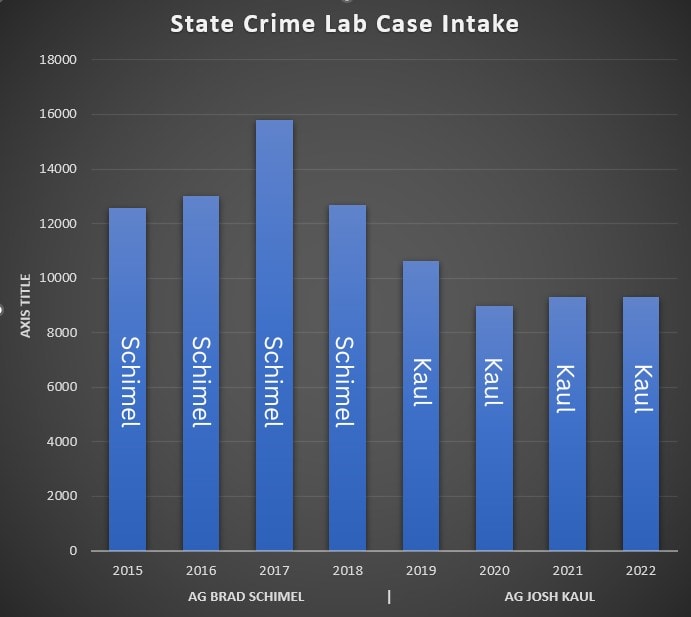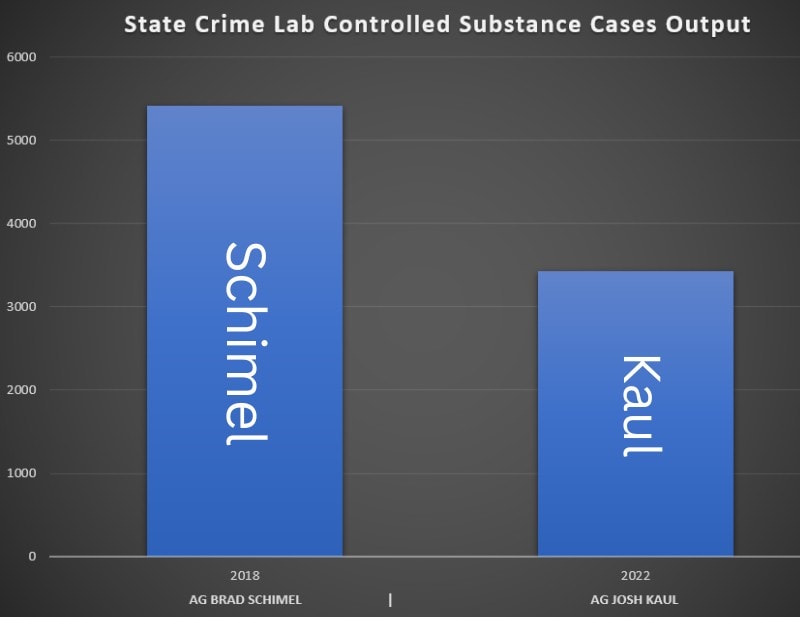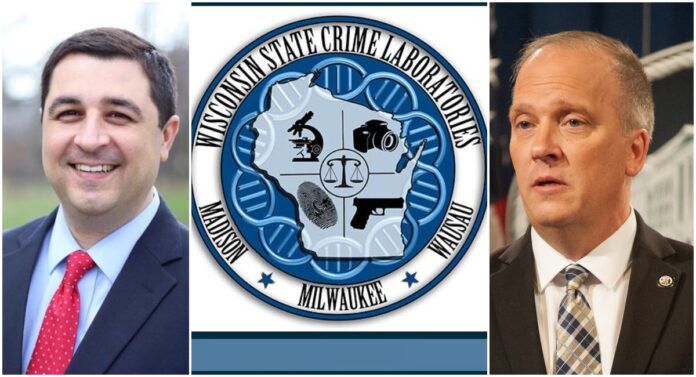Under Wisconsin Attorney General Josh Kaul, the state crime lab was far less productive and effective in 2022. He is handling 41% fewer cases than his Republican predecessor did in 2017, but his backlogs in DNA analysis and other key categories are worse, even though he has received $12 million in ARPA money to fix the crime lab. Kaul’s output has plummeted.
Wisconsin Attorney General Josh Kaul’s crime lab took longer to test DNA, controlled substances, and toxicology samples last year than former Republican Attorney General Brad Schimel did, even though Kaul’s lab accepted almost 50% fewer DNA analysis and 17% fewer controlled substance cases.
In other words, Kaul’s backlogs are worse in key categories than his Republican predecessor even though he’s taking and completing far fewer cases, at a time of exploding violent crime and drug overdoses in the state. In most of the few categories where Kaul’s lab is processing evidence faster, he’s also taking far fewer cases.
Consider: In 2022, Kaul’s crime lab took in 41% fewer cases overall than Schimel did in 2017, and it’s completed 35% fewer cases, a Wisconsin Right Now analysis of DOJ crime lab reports says. Across the board, from DNA analysis to controlled substances to toxicology, Kaul’s crime lab is much less productive than Schimel’s was, with its intake and output both spiraling down across the board, at a time of exploding crime.
 That’s despite the fact that Kaul’s 2022 report confirms, he received an extra $12 million in ARPA COVID-19 money to improve the state crime lab. Gov. Tony Evers announced $5 million of that funding in March 2022. Despite the failures, Kaul announced on August 16 that he is diverting $1.3 million in crime lab ARPA money to the Office of School Safety.
That’s despite the fact that Kaul’s 2022 report confirms, he received an extra $12 million in ARPA COVID-19 money to improve the state crime lab. Gov. Tony Evers announced $5 million of that funding in March 2022. Despite the failures, Kaul announced on August 16 that he is diverting $1.3 million in crime lab ARPA money to the Office of School Safety.
Kaul’s crime lab took an average of 84 days to process DNA in 2022, compared to 80 days in Schimel’s last year and 43 days in Schimel’s first year, even though Kaul accepted 49.6% fewer DNA analysis cases.
Kaul is taking twice as long to process controlled substance and toxicology cases than Brad Schimel did, and Kaul’s backlogs are worse than in 2020, which was the height of the pandemic.
 Kaul’s crime lab is taking longer to process trace evidence and toolmarks than Schimel’s crime lab, and his average turnaround time in the trace evidence category has also worsened since 2020.
Kaul’s crime lab is taking longer to process trace evidence and toolmarks than Schimel’s crime lab, and his average turnaround time in the trace evidence category has also worsened since 2020.
Some news articles, and Kaul’s own press release, have misleadingly claimed that Kaul’s DNA analysis backlogs are improving, In fact, Kaul’s own 2022 report shows, when you look at 1) the number of cases he’s taking and 2) the backlogs under Schimel, you get a very different view of his performance. The DNA analysis backlog improved from 2021 to 2022, but it’s still worse than every year under Schimel – and, as noted, Kaul is taking in and completing FAR fewer cases.
In some key areas, such as controlled substances, trace evidence, forensic imaging, latent prints, and toxicology, testing was slower on average at Kaul’s crime lab in 2022 than it was in 2020, the height of the pandemic. Far from improving the backlogs, his performance got worse as the years passed and the pandemic waned. When you look at median turnaround time instead of average, his crime lab is taking longer to process controlled substances, trace evidence, firearms, and latent prints.
In his own August 17, 2023, press release bizarrely touting the numbers, Kaul acknowledged, “The crime lab is a vital part of the criminal justice system in Wisconsin.”
Furthermore, a national study comparing crime labs shows that Kaul’s lab is taking longer to process firearms and toolmark cases than 200 other labs, at a time of exploding firearm violence in Milwaukee.
The failures come despite the fact that Kaul’s crime lab accepted far fewer submissions than Schimel’s. For example, Kaul’s crime lab had 9,297 submissions in 2022, according to his own report. In every year he was in office, Schimel’s office handled FAR more cases. For example, in 2016, Schimel’s crime lab accepted 13,029 cases and, in 2017, he handled 15,795. In his last year, Schimel handled 12,680 cases.
 Compared to 2017, Kaul’s crime lab is handling a whopping 41% fewer cases.
Compared to 2017, Kaul’s crime lab is handling a whopping 41% fewer cases.
Kaul took office on January 7, 2019. Schimel was AG from 2015 to 2018.
Kaul and the media relentlessly slammed Schimel for his crime lab numbers, yet the media are not giving Kaul the same scrutiny.
In 2018, Kaul slammed Schimel over Wisconsin crime lab backlogs, saying, “I’m glad to see that, in an election year, Brad Schimel has finally found the motivation to take action, but we need an Attorney General who is consistently committed to ensuring that justice isn’t delayed for victims.”
Reminder, here is how negatively the media covered Schimel’s crime lab numbers, even though they were better. In contrast, today, news outlets like the Wisconsin Law Journal are covering Kaul by adopting the spin in his press release, almost verbatim.

The numbers come from Kaul’s own 2022 report, which he released several months late.
For the first time, Kaul delayed his 2022 report in order to provide national comparisons to 200 other labs via West Virginia University’s Project Foresight. “Reviewing this data for 2022, the Wisconsin State Crime Laboratories had faster median turnaround times than those reported by participants in Project Foresight for DNA, DNA databank, controlled substances, trace evidence, and latent prints,” Kaul wrote.
However, the Project Foresight report for 2022 says that national laboratories had faster median turnaround times than Kaul’s crime lab on firearms and toolmark cases. Kaul says 3 of 8 categories were worse than the national median.
However, the national report does not provide a comparison of averages or overall case submissions per lab; in other words, it’s possible other labs handled far more cases than Kaul’s crime lab did overall. We contacted the Project Foresight organizer to request comparative overall case submission numbers for the other labs to see if they handled more cases.
Professor Paul Speaker responded, “Because of the differing areas of investigation, there is no apples-to-apples comparison to combined caseloads. For example, a blood/breath alcohol lab will have a very short TAT, while labs with trace evidence analysis as part of their analyses will have very long TAT.”
Kaul’s press release claims, “DNA analysis median turnaround times have dropped below pre-pandemic levels, as DFS continues to work through submissions of evidence from court cases that accumulated during the pandemic.” He leaves out that the median turnaround times, as with the average, were worse than they were under Schimel. He leaves out that DNA analysis turnaround times, on average, were worse than every single year of Schimel’s tenure. He leaves out the plummeting number of case submissions accepted.
Controlled Substances: FAILURE
In 2022, Kaul’s crime lab took longer, on average, to process controlled substance cases than every year of Schimel’s tenure. His lab took 84 days, twice as long as Schimel’s 2015 crime lab. The median turnaround time for controlled substances has almost doubled under Kaul when compared to Schimel’s last year (before 2018, only the average turnaround times were released).
It was the longest delay since at least 2015 in that area.
The median time also increased in 2022 when compared to 2018, Schimel’s last year.
In 2022, Kaul took 17% fewer controlled substance cases than Schimel took in 2018, Schimel’s last year.
DNA Analysis: FAILURE
Kaul’s crime lab is taking almost twice as long, on average, as Schimel’s lab did in 2015 to process DNA analysis. Schimel’s lab processed DNA faster than Kaul’s in every single year Schimel was in office.
The median turnaround time was also longer under Kaul in 2022 than in Schimel’s last year.
Kaul’s lab took in almost 50% fewer cases than Schimel did in 2018.
The DNA databank analysis is slightly faster, on average, under Kaul. However, Kaul’s office handled more than 7,000 fewer DNA databank submissions over Schimel’s last year, a 26% drop.
Toxicology: FAILURE
In 2022, Kaul’s crime lab took more than twice as long, on average, than Schimel’s last year to process toxicology cases. It was the longest delay since at least 2015 in that area.
The median was the same in 2022 for Kaul as it was in 2018 for Schimel.
However, Kaul took 1% fewer toxicology cases in 2022 than Schimel did in 2018.
Trace Evidence: FAILURE
Kaul’s office is taking longer than every year of Schimel’s crime lab to process trace evidence. It was the longest delay since at least 2015 in this area.
However, the median trace evidence turnaround time in 2022 was lower than Schimel’s in 2018.
Kaul took 22% fewer trace evidence cases in 2022 than Schimel did in 2018.
Toolmarks: FAILURE
Kaul’s crime lab is taking longer, on average, than every year of Schimel’s to process toolmark cases. His numbers have improved somewhat since 2020.
The median turnaround time is also higher under Kaul.
Kaul took 32% fewer toolmark cases in 2022 than Schimel did in 2018.
Firearms: MIXED
Kaul’s office is processing firearms faster than Schimel’s last year but slower than his first. The average turnaround time is slightly down since 2020, however.
The median turnaround time for firearms under Kaul in 2022 was longer than Schimel’s last year.
Kaul took in 20% MORE firearms cases in 2022 than Schimel in 2018, an anomaly in the numbers.
Forensic Imaging: SUCCESS
Kaul’s crime lab is processing forensic imaging faster than Schimel’s crime lab. However, the average turnaround time has slightly worsened over 2020.
Kaul’s median turnaround time in this category was slightly better than Schimel’s last year.
Kaul has dramatically boosted forensic imaging numbers, a growth of 679%.
Latent Prints: MIXED
Kaul’s crime lab is processing latent prints more quickly, on average, than Schimel’s crime lab. Kaul’s median was also better than Schimel’s last year.
However, Kaul’s crime lab is handling 34% fewer latent prints.
Footwear: MIXED
Kaul’s crime lab is processing footwear more quickly, on average, than Schimel’s crime lab. The median was also better under Kaul when compared to Schimel’s last year. However, Kaul took 11% fewer cases in 2022 than Schimel did in 2018, making the finding mixed.
Kaul has tossed out a grab bag of excuses for the increased delays in testing things like DNA and controlled substances. He’s blamed backlogs inherited from Schimel, not getting enough positions from Gov. Tony Evers and Republicans in the Legislature, the COVID-19 pandemic which resulted in social distancing and staggered shifts, an influx of fentanyl cases, staff turnover, the complexity of cases, and on and on.
Kaul has admitted that he’s taken actions that artificially reduced the caseloads handled by the crime labs, saying the drops were driven in part by changes his office made to the submission guidelines restricting what law enforcement and prosecutors can send to the Wisconsin crime labs in the first place.
Table of Contents






![Mandela Barnes Said ‘Reducing Prison Populations is Now Sexy’ [VIDEO] Reducing Prison Populations is Now Sexy](https://www.wisconsinrightnow.com/wp-content/uploads/2022/09/Collage-Maker-14-Sep-2022-11.44-AM-356x220.jpg)







![Author Exposes the Tragic Realities of the 2020 Riots & the ‘Gaslighting of America’ [REVIEW] julio roses](https://www.wisconsinrightnow.com/wp-content/uploads/2025/11/MixCollage-21-Nov-2025-02-08-PM-8145-356x220.jpg)


















